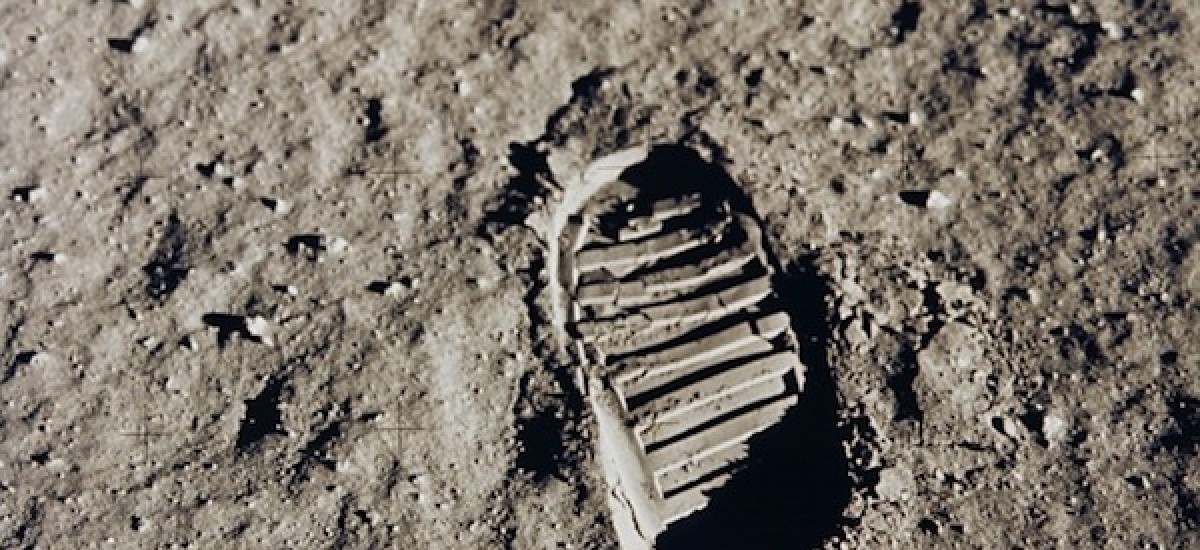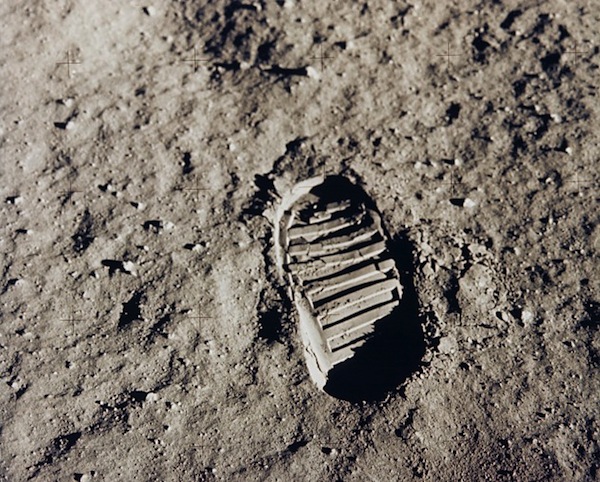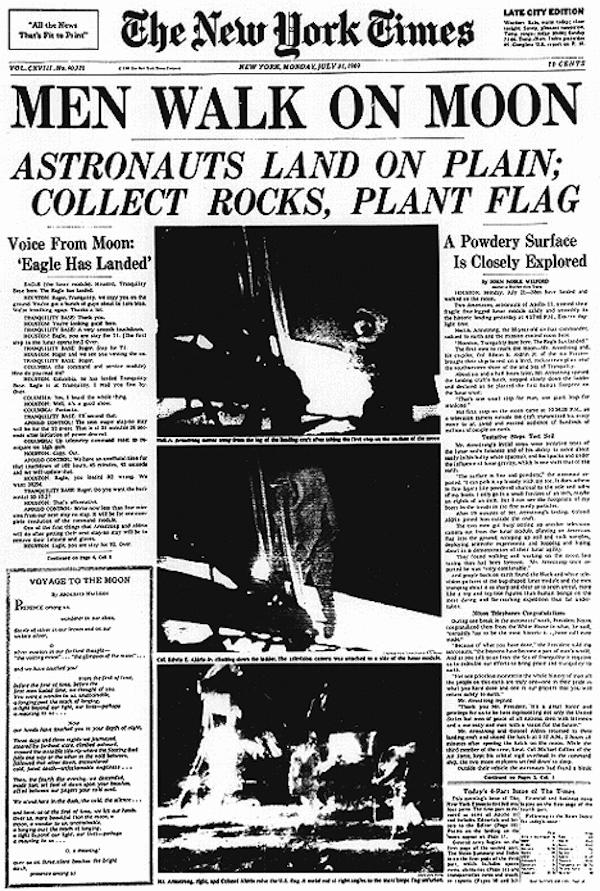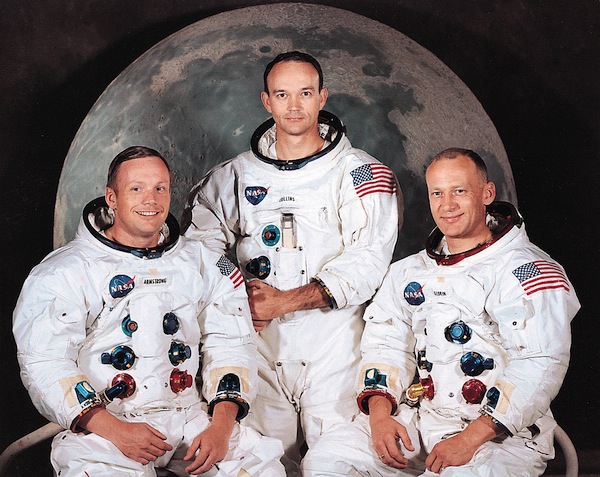Apollo 11 bootprint
When Neil Armstrong took that first ’small step’ on to the Moon, at 10.56 pm Eastern Standard Time (EST) on 20 July 1969, a quarter of humanity — following it live on radio or TV — collectively held their breath. In the next moment, our various divides disappeared…at least for a brief while.
As Arthur C. Clarke – who covered the Moon landing for CBS network – later summed up, it was “one of the great divides in human history; we are sundered from it forever by the moment when Neil Armstrong and Edwin ‘Buzz’ Aldrin stepped out on to the Sea of Tranquillity. Now history and fiction have become inexorably intertwined.”
History was not only made that day; it was also witnessed, instantaneously, by an estimated 600 million people on TV. Another few dozen millions worldwide tracked mission progress on short wave radio.
In contrast, only a handful of local people – including a solitary amateur photographer – were present on that windy morning on 17 December 1903 in Kitty Hawk, North Carolina, to see the Wright Brothers make their first successful flight.
Amazingly, only 65 years separated the two epochal moments. The march of science and technology in that time not only took men to the Moon and brought them safely back, but also made it possible for a sizeable proportion of the world population to share the experience in real time.
That made all the difference: Apollo 11, from beginning to end, was the first Big Media Moment in history.
I was part that Global Family, if only just. I was three years old at the time, and living in a country (Ceylon/Sri Lanka) on the other side of the planet – and not fully in sync with the rest of the world.
The year I was born (1966), the government had tagged our weekends to the lunar calendar, utterly confusing locals and foreigners alike. And – as I would document exactly 40 years later – the same government turned down an American offer to carry to the Moon an official message from Ceylon’s Prime Minister. Nobody knows why.
All that and more now belongs to another century and altogether different era fast receding from our memories. Indeed, half of humans alive today were not even born when Neil & Co left those expensive footprints on the Moon – along with a plaque that said “We came in peace for all mankind.”
For many of us who experienced it, however, the ‘Moon shot’ will be among our most indelible memories. Among the various labels I can choose from those tumultuous times, I consider myself a Child of Apollo.
And the boyish, blue-eyed Neil Armstrong (already 39 when he went to the Moon) was my first hero.
NYTimes 21 July 1969
Yes, that dates me a bit, but I won’t have it any other way. In her novel The Moon in the Water (2009), Lankan author Ameena Hussein uses a memorable line to describe her protagonist’s many dilemmas: “Her generation had the burden of being the link between the old world and the new. Between pre-man in the moon and post. Between letters and e-mail.”
I’m as much a part of that in-between generation as her character Khadeeja. Rather than being a burden, however, I find it an extremely privileged vantage point to have been. There will never be another generation like ours…
Space Odysseus
Born in the American Midwest (Ohio) and raised during the Great Depression of the 1930s, Armstrong was an unlikely American hero and global icon. He remained uneasy with such labels all his life.
Yet he stepped into history books precisely at a time when the world needed good news and heroes. The Apollo 11 crew who traversed the vacuum of space half a million miles – to the Moon and back – helped fill a socio-cultural vacuum as the troubled 1960s were drawing to a close.
Yuri Gagarin, the first human to travel to space — making a single Earth orbit of 108 minutes on 12 April 1961 – then spent the next few years of his playing the decorated Hero of the Soviet Union. He probably didn’t have a choice being paraded worldwide as ‘Exhibit A’ of the Soviet propaganda machine.
Gagarin’s accidental death in March 1968 – aged 34 – deprived the Space Age of its first Odysseus all too soon. Fifteen months later, when Neil Armstrong rode that gigantic chariot of fire called Saturn V, we quickly anointed him as a successor. The new age of exploration needed its own intrepid voyagers.
Before and since, there have been many remarkable astronauts and cosmonauts carrying out even more challenging – and hazardous – space journeys. Apollo 13’s mid-course explosion and its dramatic rescue was a real miracle. The Apollo-Soyuz joint mission in July 1975 was a near incredible feat for the Cold War.
Since Gagarin’s maiden flight half a century ago, a total of 528 humans from 38 nationalities have been to outer space (up to 30 June 2012). Of them, 18 have died in inflight accidents. We celebrate and salute them all – but as with Olympians – we make icons of only a very few.
Astronauts come in all shapes, colours and personalities. Some like Alexei Leonov (first man to walk in space) and Buzz Aldrin are ebullient extroverts who sustain the momentum of their extraterrestrial exploits for decades (modest cough: I’ve met them both). Others, like Neil Armstrong, prefer to just do it well — and not talk too much about it afterwards.
Poetic Engineering
Many tributes Neil Armstrong have noted how extraordinary it was that he was unpretentious and remained unaffected by his enduring global fame. Not all Moonwalkers handled that elite status with such grace and humility.
When he returned from the Moon, Armstrong could have done (almost) anything he wished. It’s hard to imagine someone in his position playing down his individual role – and crediting hundreds of thousands who had toiled for much of the 1960s for this moment of glory.
“I was a test pilot, not an adventurer,” he insisted at the time. He told an interviewer many years later: “I wasn’t chosen to be first. I was just chosen to command that flight. Circumstances put me in that particular role; that wasn’t planned by anyone.”
60 Minutes Interview with Neil Armstrong, 2005 (13:45)
In that same 2005 interview, he asked: “How long must it take before I cease to be known as a spaceman? I guess we all like to be recognised not for one piece of fireworks but for the ledger of our daily work.”
Armstrong did play the dutiful astronaut hero – for a short while. With Buzz Aldrin and Michael Collins, he toured the United States and 22 other countries upon their return. He even accepted an elevated NASA position – as Deputy Associate Administrator for aeronautics.
But he was as uncomfortable with bureaucracy as he was with fame. He left NASA in 1971 and took to teaching aerospace engineering at the University of Cincinnati – after apologising to other faculty members that he didn’t have a PhD. Eight years later, he resigned and retired to a farm in Ohio – spending the next three decades as a recluse.
Although he did make a few corporate endorsements, he was fiercely protective of his privacy. He declined most autograph and interview requests. He avoided politics and religion, turning down all offers of political office and describing himself as a deist — a person whose belief in God was founded on reason rather than on revelation.
Apollo 11 Astronauts (L to R) Neil Armstrong, Michael Collins, Edwin Aldrin
Not for him, clearly, the heroics and grandstanding of Captain James T Kirk (Star Trek) or some of his real life contemporaries. But if he was a man of few words, he chose those words thoughtfully – with almost poetic elegance.
For instance, standing on the Moon, Armstrong noticed that he could blot out the Earth with his thumb. Did that make him feel really big, he was asked. “No – it made me feel really, really small.”
While that humility characterised the second Odysseus of the Space Age all his life, he was just as awestruck as all space travellers were. Questioned if there was ever a moment on the Moon when he was ‘just a little spellbound by what was going on’, he replied: “About two and a half hours.” (The total time spent on the surface.)
On another occasion, a journalist queried about his biggest difficulty on the Moon. Armstrong replied: “We had the problems of a five year old boy in a candy store. There were just too many things to do!”
Igniting Dreams
I was two years younger than that age when all this happened. The events signify something else for me: the first Moon Landing is my earliest childhood memory that I can pin down to a specific date. And boy, what a date!
By then, 1969 was already the most eventful in my (very short) life of three years. In April, a younger sister was born. And at the beginning of July, I started pre-school. I should have at least hazy recollections of these events imprinted in my (usually sharp) memory. But there is none.
What I do remember, instead, is the heightened excitement over the Moon Landing. My father was listening to the live radio broadcast on Voice of America. Sri Lanka had no television broadcasts (that would arrive only 10 years later), so our only choice was radio….or the next day’s newspapers.
The crackling shortwave transmissions came in loud and clear (most of the time) through the large radiogram that sat in a prominent corner of our living room. At over three feet in height, and encased in well polished teakwood, that formidable instrument dwarfed little me.
I sat eagerly in front of the talking box, our solitary window to the world. I realised something important was happening, yet I couldn’t understand what the commentators were saying in a strange accent. English was still an alien language – at that tender age, I was still picking up my mother tongue Sinhala!
But the inquisitive brat that I was, I asked my father to give me an occasional summary of what was going on. His school teacher experience must have helped.
After all these years, I can’t remember too many technical details. But the highlights linger. Armstrong’s one small step was taken. Then he and Aldrin hopped around like kangaroos; planted the American flag; set up scientific instruments; and collected lunar soil samples.
They talked as they worked. Mission Control closely followed their every move…as did the whole world. Sharing it in real time was a huge public relations gamble for a venture so complicated and unpredictable. Hollywood couldn’t produce a bigger suspense thriller…
Soon, it was time to head back. I would later read that leaving the lunar surface was the most tensed moment in the entire mission. The astronauts had one chance to rejoin the ‘mother ship’ orbiting the Moon. If the lunar module failed to take off, they’d be marooned on the Moon with absolutely no hope of a rescue.
Having spent just over 1,000 days on Earth myself, I had no idea about these dangers. But, according to reliable family witnesses, I posed one ‘tough’ question to my father: “What if the astronauts get stuck – and can’t return?”
I have long forgotten what answer he gave me. His background was in history and languages, not science. Perhaps it was an early indication that I was going to be asking many difficult — sometimes irritating — questions.
Forty years on, I haven’t stopped.
Watch Neil Armstrong’s Last Interview, given in May 2012.
###
Science writer Nalaka Gunawardene regularly switches between terrestrial and extraterrestrial topics to the confusion of who try to pin down his interests. Grown ups and intellectuals are advised reader discretion when visiting his blog at http://nalakagunawardene.com




